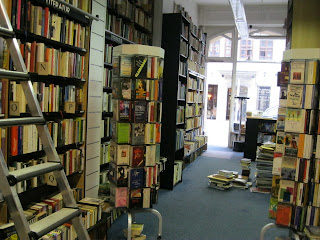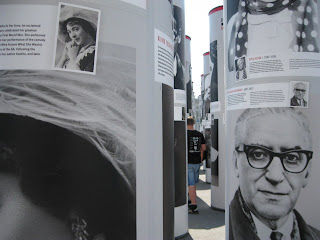"Mein Leipzig lob' ich mir! Es ist ein klein Paris und bildet seine Leute."
"I praise my Leipzig! It is a small Paris and cultivates its people."
-Goethe, Faust
---------------------------------------------------------------------------------------------------------------------
Yesterday, my first day back in Berlin after a few days in Leipzig, I went to
my favorite discount grocery store to buy food for the week. I was about to bring my camera, and then I thought -- that's silly. I'm just going grocery shopping. There's nothing to photograph.
Then I passed by a street full of adorable cafes, a park with a waterfall, and a shed in an enclosure with a goat standing on the roof.
Berlin is like Hogwarts:
There are weird, surreal things around every corner. People dress funny. One arrives there via a red train. It's primarily populated by young people. It has a long and complex history involving various camps who were once united, then fell into discord, and then reunited in the end. Haribo is essentially Honeydukes. Potsdam is essentially Hogsmeade. Many people, including the woman I stayed with for my first two nights, have an eclectic sense of decor, like The Burrow (or in this case, more like a pirate ship in a cartoon).
 |
| Exotically dressed mannequins stood on either side of my bed. |
 |
| There was also a blue piano with a blue lamp that emitted blue light. Several stuffed tigers stared at me while I slept, squashed between the panes of a double-pane window. And about 1,000 other things like that, all within one apartment. |
The place I stayed for my first two nights was truly surreal. And at first I
thought the goat on the roof was similarly surreal, but then I did a little "research" (in other words, ich hab's gegooglt) and discovered that goats, for some unknown reason,
really enjoy hanging out on rooftops. There's even a collector's board game from the 1960s entitled "
Hey Pa! There's a Goat on the Roof."
Anyway.
---------------------------------------------------------------------------------------------------------------------
LEIPZIG is basically like a mini-Berlin (Hogwärtchen?) in some ways, mini-Paris in others. (I've actually never been to Paris, but if Goethe says so, it must be true.) There are tons of hip eateries and bars, along with plenty of hip hipsters to eat and drink at them. Since Leipzig is historically the book-publishing center of Germany, the atmosphere feels distinctly intellectual. And of course it's a musical city, home to Bach, Mendelssohn, Schumann, Telemann, and
this very enigmatic monument to Beethoven created by Max Klinger in 1902, as well as most of the major music publishers.
My first stop in Leipzig, straight from the Hauptbahnhof, was the
Thomaskirche. The church, which dates back to the 12th century, was Bach's place of employment for almost 30 years, where he composed a cantata per week, taught music, and made sure the schoolboys were getting to bed on time.
 |
| The Thomaskirche. |
 |
| Nowadays, the church is Bach Central. |
 |
| From the inside: serene, whitewashed, austere... Lutheran. |
 |
Where's Waldo Bach? |
 |
| There he is. |
 |
| Where's Bach? Oh wait, that's literally his tomb. There's a flower vendor outside the church -- people buy flowers on their way in, then set them on his grave. |
 |
| A group of Italian schoolkids were getting an organ demo, with the organist isolating the timbres of the various stops. |
I also visited the
Bach museum next door. I truly think it's one of the best museums I've been to. Most museums are one of two extremes: either too sparse and totally boring, or too busy and overdesigned, almost like childrens' museums. This museum had a perfect balance: it was straightforward, informative, but also interactive and
interesting, not just facts floating around untethered to reasons one might want to know them. For example, the museum has an area where you learn how to date a Bach manuscript by solving various manuscript-puzzles, the answers to which are hidden in a pull-out panel. One wall sports a map of Bach's family tree, in which names of various members of his musical dynasty light up and the overhead speakers play music written by that composer -- Bach's uncle, second cousin, great grandfather, etc. There are of course some Bach relics, like his organ console, as well as a dark room explicitly designed to evoke Tutanhkamun's tomb (with
the famous "yes, wonderful things" quotation on the entrance wall) that displays autograph manuscripts, letters, and of course weird items found in Bach's grave, enshrined in a reliquary from 1900. But for me, the highlight of the Bach museum was the "Hörkabinett" (listening studio), in which visitors wear headphones, sit at a console, and select from
any of Bach's works to listen to for as long as they want. I think every composer museum should have something like this. Rather than reinforcing the composer's usual top 10 hits, the listening room lets you probe through hundreds of pieces and discover new works you didn't know existed. (I suppose it's also possible to carry a
portable Hörkabinett with you... but somehow it's not as special.)
Later in my trip, I also visited the
Nicholaikirche, which I thought was really stunning. 12th century exterior, 18th century interior, and cool frescoes:
My main activity in Leipzig, however, was meeting with professors. One of the profs I met with looked exactly like a grown-up Harry Potter -- and no, I don't just say this because I'm interpreting my entire trip through a potterified lens, he actually did look like Daniel Radcliffe's older brother or uncle or something. He was friendly, helpful, and also super awkward. Most of our meeting consisted of expectant silence (even though I was desperately trying to talk as much as possible) and during these awkward hiatuses he would tear open a tiny package of stale Haribo gummy bears and scatter them on the table in front of me. As I left, he scooped up about half his Haribo supply and dumped it in my tote bag. Er... thanks...!
Haribo aside, the quirky prof said something that stuck with me for the rest of my stay. I commented on how pretty the buildings are in Leipzig -- the entire city is filled with enormous, ornate buildings in the
19th-century Wilhelminian style of architecture. The prof said that the Leipzig stereotype is enormous, beautiful buildings that are mostly empty. And sure enough, some parts of the city (mostly outside the downtown) looked a little gaunt and empty, too grand a scale for the actual population.
 |
| The Bundesverwaltungsgericht (Federal Administrative Court). |
 |
| The downtown area. |
 |
| Another downtown street near the Nicolaikirche. |
 |
| What Leipzig is truly known for: books books and more books. |
 |
| Strolling around. |
 |
| Canals with water-lilies. |
 |
| The hip part of town. |
 |
| A colorful building -- perhaps the only building that actually complements the construction. |
 |
| Window-shopping. |
 |
| A walk in the park yields an unexpected peek into the setting of Pride and Prejudice. |
The following day, I met with two other professors. Considering that my German is... er... "in einer Entwicklungsphase," I would say the meetings went well. The downside, however, is that the professors gave me completely opposite advice. One of them advocated writing a dissertation that thoroughly analyzes about 1/1,000th of the material I'm currently planning to cover; i.e., honing in on two specific years and one specific genre of one specific type of Beethoven reception, with no other composers. He justified this by saying, "That's what a reception history is about. That's science [
Wissenschaft -- and in German, musicology is
Musikwissenschaft]. This cultural studies stuff [
Kulturwissenschaft], that's no science." Then his eyes flicked in the direction of his colleague down the hall, he turned red, and he said "I know, I'm being mean..." Later that afternoon I met with the colleague down the hall, who told me that I should avoid writing a reception history and should really be doing more of a broad
Kulturwissenschaft that takes various composers into account. Thus, after my conversations with professors in Leipzig, I feel newly inspired to read everything in the world, as well as totally and completely confused. (Which actually is
how I feel most of the time in grad school, anyhow.)
Finally, I visited the Mendelssohn House, and then sadly ran out of time to see the Schumann House. I'm not Mendelssohn's biggest fan, but seeing his house with its Biedermeier-style rooms and furniture was fun regardless. I was totally amazed by the room of Mendelssohn's paintings -- I read once in an article that he was a gifted landscape painter, but I never realized just how gifted.
 |
| I don't think I was supposed to take photos... but oh well. These two were my favorites. |
 |
| One of the rooms in the house with original furniture, reconstructed from the painting below. |
 |
| A pleasant view from the window. |
 |
| In the music salon, proving that I exist. At the end of this trip, there will be a contest to see which of the self-photos is the most awkward. |
 |
| A sleepy stray that lives outside the house. Mendelssohn reincarnated? Mendelssohn's pet cat reincarnated? |
On the way out of the city, I stopped at the Staatsarchiv, which is located in an ugly building in an ugly suburb. I took a look at all the documents related to advertising from the Peters Verlag, one of the biggest music publishers in Leipzig. I was hoping to find information about other composer-related objects that Peters might have sold, as well as get a flavor for how they tended to advertise their publications.
The result, however, was the gloomy underbelly of archival research. I sat in a dark and freezing cold room, wearing too little clothing (owing to my silly notion that IT'S SUMMER), panning through random documents on microfilm, and finding absolutely nothing interesting for three hours. The documents were so boring that at a certain point I stopped reading them, and just panned through the microfilms slowly out of a sense of obligation to the archivists who had retrieved them. I was supposed to stay there all day, but by noon my stomach was growling. I knew that there wasn't a single place to get food nearby, having walked over from the train station and seen nothing except parking lots, an auto dealer, and a massive home improvement store called Toom. At this point, a little voice in my head whispered please get me out of this sad, sad place; so I caught the regional train back to Leipzig Hauptbahnhof, ate a superb falafel sandwich in the station, and headed back to Berlin. In conclusion, microfilm saps all the life and joy out of archival research. It doesn't feel like you're looking at exciting dusty manuscripts anymore... it just feels like slowly scrolling drudgery. "But Abigail," I hear you say, "It's what's inside the documents that counts." That's true. Maybe my response was simply due to the utter dullness of the documents themselves. I suppose that, whether it's on microfilm or paper, archival research is only fun when there's a feeling of discovery, so that when the archivist comes over and asks, "Are you finding anything?" you can say, "Yes, wonderful things!"







































































